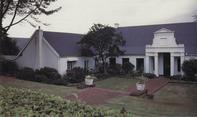Victorian Public School
Hilton, possibly more than any other historic school in South Africa, illustrates the efficiency with which the pattern of the Victorian public school was stamped on the highly individual character of the Natal midlands.

The school had its scholastic beginnings at the hand of Reverend William Orde Newnham, the man chosen by Bishop Colenso on one of his return trips to England to be the master of his envisaged new grammar school in Pietermaritzburg. Colenso, Newnham and a boatload of immigrants landed at Port Natal in May 1855. Shortly thereafter the school was up and running and Newnham had taken upon his shoulders the tasks of a colonial schoolmaster.
A man of scholarly ambitions, he must have been a little discouraged by the backwardness of his pupils, who had up to that time had more use for their hands, working on their parents' lands and in their parents' trades, than their heads. A dim light in that dark unintellectual tunnel was the friendship he struck up with Gould Arthur Lucas, a bond that was to culminate in the founding of Hilton College.
When in 1866 the nearby German Hermannsburg boarding school increased its boarding accommodation with the result that numbers at that school rose immediately from 45 to the full complement of 80, Newnham realised that there was a demand for higher boarding-school education in the colony. The entire school complement - Newnham and his family, 50 boys and an assistant master - arrived at the site of their new home in ox wagons and on horseback at the beginning of 1872.
Rugby Tradition
In 1872 the cadet corps, known as the Hilton College Guard, was formed. The following year, in the mould of Dr Arnold's Rugby school, prefects were appointed at Hilton; one of these was Ernest Acutt, later to become mayor of Durban and the moving force behind the company Hilton College Limited.
Hilton's rugby tradition dates back to around this time. The high schools in the area all played soccer, which meant that Hilton - the first school in Natal, and one of the first in the country, to play handling football - had no rugby-playing rivals, but in 1872 Bishop's College opened its doors in Pietermaritzburg and gave Hilton some good games over the near-decade of its operation.
Newnham was also a fan of cricket, appreciating the patience and perseverance that had to be shown in the playing of the game. The first match played competitively at Hilton was in 1872, against Pietermaritzburg High School. The home side won this encounter, but the high school won the return match.
By 1876 Hilton was well established, with enrolment standing at 73 boys. Sadly, Newnham’s health began to fail and, aware that his lease on the property was due to expire in 1880, he began restricting the number of boys admitted to the school. In 1877 Newnham, the father of Hilton College, virtually abandoned his charge, returning to England with his family.
Headmaster Ellis
Henry Vaughan Ellis, a product of Rugby school in England, took over as head in 1878. One of the first things Ellis did was to introduce a stricter monitorial system, giving the prefects considerably more power over their schoolmates than had Newnham.
The success of this system depended on the strength of character of the senior boys who held these positions; Ellis, who believed implicitly in the goodness of the nature of boys, was fortunate in having three successive head boys of exceptional calibre, and on the whole the system worked smoothly.
Ellis was even more devoted to the game of rugby than his predecessor Newnham had been, and continued to encourage the sport at Hilton. He introduced the fleur-de-lys that was worn on the rugby jersey and changed the colours from the red and white worn during Newnham's time to the black and white (or, more correctly, sable and argent) that are still worn today. Popular tradition has it that Natal's rugby colours derived from those of Hilton College, which in turn took its colours, emblem and motto from Rugby school.
Peaks and Troughs

The years up to the end of the 19th century were a time of peaks and troughs at Hilton College. Staff turnover was rapid, neither the salaries nor the working conditions being attractive enough to lure and keep qualified teachers. The outbreak of the Zulu War, and fighting in the Transvaal following its annexure by Shepstone, made for uneasy conditions in Natal; and the tragedy of the Isandlwana massacre claimed the life of at least one Hiltonian.
A depression followed soon after the end of the war in the Transvaal, which severely affected school attendance rates; by 1888 Hilton had just 36 boys on its roll. Nonetheless Ellis continued with the physical expansion of the school, cutting down gum trees to clear space for further construction, building a dining hall, offices and a cricket pavilion. Just before the turn of the century, things started looking up and Hilton opened in its new term with 96 boys enrolled.